“Art is like a joke, either you get it or you don’t.” So it was explained to me in the late 1970s by photographer Randy Eriksen, whose cheeky observation about the importance of context to one’s appreciation of either comedy or art could have been a parenthetical second subtitle for author and educator Kim Beil’s “Good Pictures: A History of Popular Photography” (Stanford University Press, 2020).
Beil’s episodic and highly readable book identifies 50 photographic trends—illustrated by hundreds of vintage and contemporary photographs—that have guided the aesthetics of photography since 1851, when a group of American daguerreotypes made a splash at the Crystal Palace Exhibition in London. Back in 1851, context mostly equaled 1851, as the latest photo technology of the day played a major role in how Victorians decided that one picture was good and another was not.
The tech in question at that time, Beil writes in “Good Pictures,” was “the American process,” a procedure in which bromine, iodine, chlorine, and silver, when applied to a polished copper plate, produced daguerreotypes of greater clarity and tonal range than those of British or even French photographers, which was saying a lot since the dominant photographic form of the mid-19th century took its name from its French inventor.
The debut of the American process at the Crystal Palace showed how a single advance in photography technology at a particular moment in history could instantly define what people considered a good picture. In 1851, if you had become used to looking at daguerreotypes that were dark and blurry, you immediately “got” that the ones imported from the former colonies were better. You now had taste.
Beil’s own context began in Albany, New York, where she grew up. “My mom was into photography,” Beil tells me over the phone. “She was the one who took the pictures in my family. When my parents got me my first camera, a Nikon FE, they made me attend a class offered by the camera store. I remember it was held in this dark ballroom at an Albany hotel. It was me and a bunch of middle-aged men. That’s where I learned about 35mm cameras, f-stops, and shutter speeds.”
Beil also learned from various “How to Make Good Pictures” manuals published by Kodak, which also hailed from upstate New York. “I’m pretty sure I internalized the advice I read in ‘How to Make Good Pictures,’” Beil says of her early aesthetic indoctrination, “things like avoiding centering your subject in the frame, the rule of thirds, shooting during ‘golden hour,’ all that conventional wisdom.”
